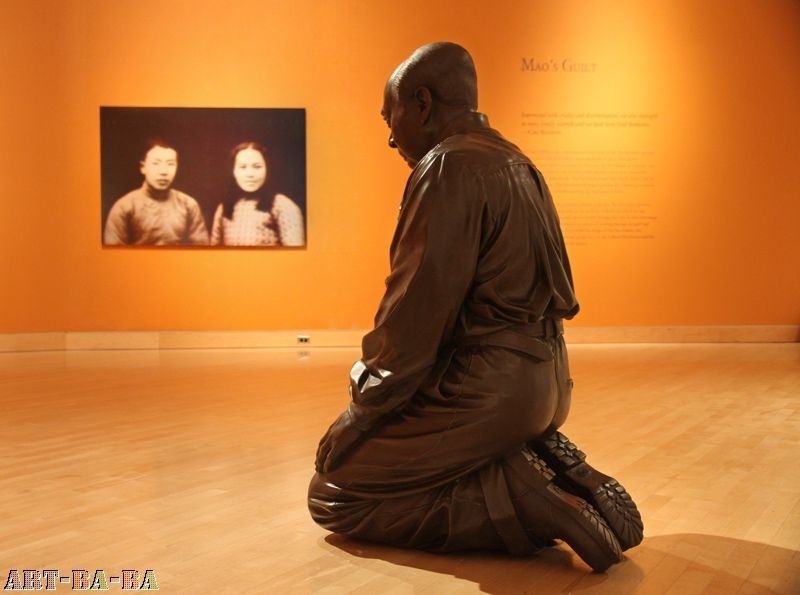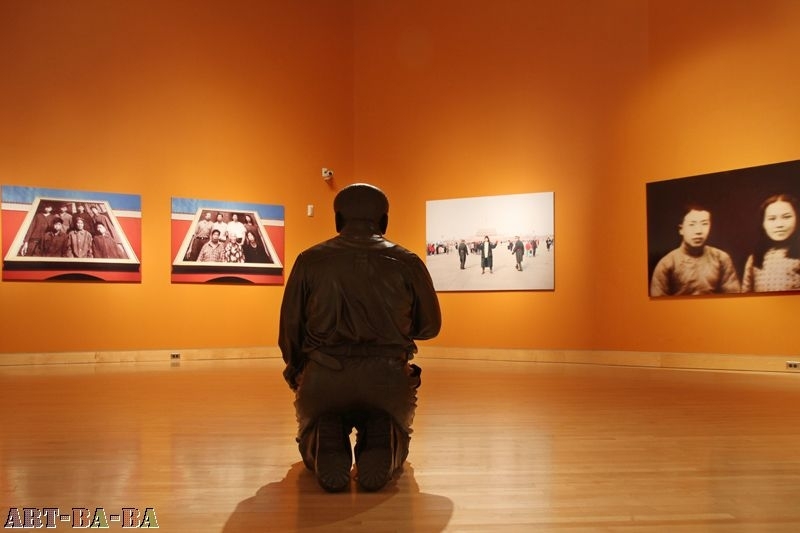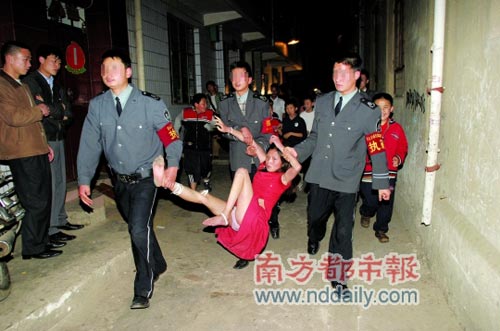二十二周年纪念
在《忏悔吧!M》文章中写道:“他跪下了!虔诚地跪下了!双膝跪地忏悔他所犯下的滔天罪行!左手放在脚上,右手捂住右胸(心)!头发与双眉如霜,双目紧闭,面部苍老凝重,表现出深重罪孽所带来的痛苦。”
文中还认为M是“东方帝王与西方极权两种最邪恶思想的结合体,他毁灭了中华五千年的文明,屠杀了八千万的生命,无情地摧残了人性,位列于二十世纪三大杀人魔王 (M、斯大林、希特勒)之首。
他认为世界上没有神,所以无所畏惧,他自命为神,所以无所不能,无所不为。” 所以M“他应当跪在所有的中国人的面前忏悔!他应该跪在中华民族文化面前忏悔!他应当跪在人类的良知面前忏悔!”
处决耶稣-毛泽东行刑队
《下跪忏悔的毛》在“壮观与宣泄——高氏兄弟艺术展”中展出
据了解,这个下跪的M像名叫《下跪忏悔的毛》,是中国前卫艺术家高兟、高强的作品。此作品曾在2010年917日美国堪萨斯KEMPER当代艺术博物馆“壮观与宣泄——高氏兄弟艺术展”中展出,并一直持续到2011年的1月2日。
《下跪忏悔的毛》其比例等同真人大小,在雕塑周围是一系列文革前后高氏兄弟一家的照片。据悉1968年,高氏兄弟的父亲被打为反革命,被关押二十五天后被告知他们父亲自杀身亡。
高强、高兟兄弟
其中高氏兄弟的作品“毛小姐企图稳站列宁头上”的大型不锈钢雕塑,去年在加拿大列治文市埃尔姆桥路夹奥尔德桥路的交汇处展出时,就引来当地中英媒体竞相报道,及社区华人激烈争议。
有网友认为,知识份子对体制与历史的抨击虽然不多,但也不少,辛辣智慧而幽默的,倒是的确少的。大多数人惟恐避让不及,其中有三种可能,一种是恐惧于被批评者的打击报复,一种是对批评者的轻蔑,一种是对批评者的批评。但高氏兄弟的批评,严格说来应该是讽刺,通过幽默和艺术,使得作品具备了丰富的想像空间,给对手留下对号入座的可能。更有网友指出:“让老猫下跪,是太抬举它!”
SARCASM AND SINCERITY
A review of The Gao Brothers: Grandeur and Catharsis

Gao Brothers, (wall, from left to right) "Two Portraits of Hitler," oil on canvas (diptych), 157 ½" x 236 ¼”, 2008 and "Portrait of Dalai Lama," oil on canvas, 157 ½" x 118 ¼”, 2010 and (foreground/center) "Miss Mao No. 3," stainless steel, 98 ½" x 71" x 59”, 2007; courtesy of the artists. Image: from the exhibition “The Gao Brothers: Grandeur and Catharsis” at the Kemper Museum of Contemporary Art, photo courtesy of the museum
Kemper Museum of Contemporary Art
Kansas City, Missouri
September 17, 2010 — January 2, 2011
The Gao Brothers: Grandeur and Catharsis is the first solo American museum show by this prominent duo of mid-career Chinese artists who have been collaborating since 1985. Organized by London-based independent curator Arthur Hwang with Kemper curator Barbara O’Brien, and comprising paintings, sculptures, and photographs, the exhibition offers a generous sampling of the Gao Brothers’ recent work, much of it revolving around the figure of the Chinese Communist leader Mao Zedong (1893-1976), and alternating in tone between sarcasm and sincerity.

Gao Brothers, "Miss Mao Trying to Poise Herself at the Top of Lenin’s Head," stainless steel, 256" x 236 ¼" x 165 ½”, 2009, as installed on the east lawn of the Kemper Museum of Contemporary Art from the exhibition “The Gao Brothers: Grandeur and Catharsis;" courtesy of the artists. Photo: David Cateforis
Like millions of Chinese of their generation, Gao Zhen and Gao Qiang (born in Jinan, Shangdong Province in 1956 and 1962, respectively), were deeply affected by the Cultural Revolution (1966-1976), the movement Mao led during the final decade of his life to consolidate his power through the persecution and, often, execution of millions of supposed Chinese “counter-revolutionaries.” Among the victims was the Gao Brothers’ father, Gao Wen Chen, a factory worker who was arrested in October 1968 and sent to the countryside for “re-education.” Soon thereafter the family was told that he had committed suicide; believing that he had actually been shot and killed, the Gaos petitioned the government for compensation, eventually receiving the equivalent of $290.
In recent years the Gao Brothers have exacted a measure of revenge through their series of Miss Mao sculptures, begun in 2006. These images mock the Great Helmsman by depicting him at bust length with a baby face, a Pinocchio nose (indicting him as a liar), and shapely breasts, making literal Mao’s identification of himself with the motherland. Too inflammatory to exhibit in China, where the authorities censor artwork critical of the government, the Miss Mao series has been widely shown outside of that country. It was first brought to Kansas City by the Byron C. Cohen Gallery for Contemporary Art, which a few years ago facilitated the Kemper’s acquisition of a shiny red, nearly seven-foot-tall version of Miss Mao (2006; not in the current exhibition), whose gaping mouth displays sharp incisors and a protruding tongue. Presently at the Kemper, a Miss Mao appears on the east lawn outside the museum as a small figure holding a balancing bar and standing atop an enormous, horizontally segmented head of Vladimir Lenin. Entitled Miss Mao Trying to Poise Herself at the Top of Lenin’s Head (2009), this 21-foot tall composition in gleaming stainless steel (dubbed “the big shiny” by the students of the adjacent Kansas City Art Institute) demeans Mao not only by feminizing him but also by presenting him as a puny and precarious ornament perched atop the awesome head of the instigator of the Russian Revolution that inspired the Chinese Communist Party.

Gao Brothers, (wall, from left to right) "Standard Hairstyle — Mao Zedong, Deng Xiaoping, Jiang Zemin, Hu Jintao," oil on canvas (four panels), 157 ½ " x 472 ½”, 2009 and "Outer Space Project - Map of China," chromogenic color print, 94 ½" x 115 ½”, 2008 and (center/foreground) "Miss Mao No. 3," stainless steel, 98 ½" x 71" x 59”, 2007; courtesy of the artists. Image: from the exhibition “The Gao Brothers: Grandeur and Catharsis” at the Kemper Museum of Contemporary Art, photo courtesy of the museum
Inside the Kemper’s main gallery, Miss Mao is again present as an eight-foot-tall bust in mirrored stainless steel (Miss Mao No. 3, 2007), with ballooning, cartoon-style breasts and a pigtail running down his/her back — a reference, according to curator Arthur Hwang, to the queue worn by the Manchu rulers of China’s Qing dynasty (1644-1912), implicitly critiquing Mao as a new emperor. Miss Mao No. 3 faces a wall displaying Standard Hairstyle (2009), a quartet of huge (nearly 13-by-10-foot) photo-based, op-art inspired, black-and-white portrait paintings of the heads of Mao Zedong and his three successors at the helm of the Communist state: Deng Xiaoping, Jiang Zemin, and Hu Jintao. All of them are shown with Mao’s characteristic hairstyle, humorously signaling that, in the Gao Brothers’ words, “Deep down, they are all the same. They are all leaders of a one-party state.”

Gao Brothers, "The Gesture," bronze, 95" x 27" x 26 ½”, 2007; courtesy of the artists, from the exhibition “The Gao Brothers: Grandeur and Catharsis” at the Kemper Museum of Contemporary Art. Photo: David Cateforis
In a corner next to Standard Hairstylestands another critical work, The Gesture (2007), a life-sized bronze statue cast from an ordinary, anonymous Chinese citizen — a portly man standing naked on a television set with eyes closed, his right hand raised in a salute imitating Mao’s greeting to the masses, and his left hand holding an object meant to represent a gold brick (but appearing to be an ordinary brick, thus failing to communicate the artists’ intention). A cumbersome critique of the contradictory coexistence in contemporary China of communism (symbolized by the gesture) and capitalism (symbolized by the gold brick), as well as the influence of propaganda and advertising (symbolized by television set), this heavy-handed work is one of the exhibition’s low points. Also disappointing is the adjacent Outer Space Project — Map of China (2008), a nearly 10-foot-wide digitally composed black-and-white photograph that renders China’s landmass as a honeycomb, each of its compartments occupied by one or more citizens going about their daily routine in isolation from one another — a trite metaphor for urban alienation. Little better is another digitally composed photo hanging in the Kemper’s lobby, The Forever Unfinished Building No. 4 (2008), a large vertical composition that scatters scores of tiny figures, including everyday Chinese as well as iconic personages (e.g. the Crucified Christ, Spiderman, and Osama Bin Laden) within the cavernous spaces of a high-rise building abandoned mid-construction in Jinan. Intended to liken China to “one unfinished building still undergoing construction” and filled with references to such events as the 1989 Tiananmen Square massacre and the 2008 Sichuan earthquake and Beijing Olympics, the photograph was probably great fun to compose on the computer but comes across as a self-indulgent exercise offering little payoff to the viewer.

Gao Brothers, (wall, from left to right) "Our Parents No. 2," chromogenic color print, 47 ¼" x 71”, 2008, "Family Memory 1969–1999," chromogenic color print, 47 ½" x 118 ¼”, 1999, "Mass In Tiananmen Square," chromogenic color print of a performance, 48" x 71”, 1995, and "Our Parents No. 1," chromogenic color print, 47 ¼" x 71””, 2008; and (foreground) "Mao’s Guilt, bronze, 45 ¼ x 28 ½ x 30 ¼”, 2009; courtesy of the artists. Image: from the exhibition “The Gao Brothers: Grandeur and Catharsis” at the Kemper Museum of Contemporary Art, photo courtesy of the museum

Gao Brothers, "Two Portraits of Marx," oil on canvas (diptych), 157 ½" x 236 ¼”, 2007; courtesy of the artists. Image: from the exhibition “The Gao Brothers: Grandeur and Catharsis” at the Kemper Museum of Contemporary Art, photo courtesy of the museum
Opposite The Forever Unfinished Building No. 4 at the entrance to the main gallery hangsTwo Portraits of Marx (2007), a monumental 13-by-20-foot diptych comprising an oil-painted portrait of Karl Marx on the left and a giant skull on the right. Suggestive of flickering images on a television screen, Marx’s portrait is rendered in wavering diagonal lines of black, yellow, red, and blue (which up close dissolve into a Bridget Riley-style op abstraction), while the skull is limned similarly in grisaille. Beyond its obvious memento mori symbolism, the diptych invites reflection on the fate of genuine Marxism in a contemporary China still ruled by the Communist Party but now embracing capitalism. Two similarly monumental diptychs,Double Portrait — Hitler (2007) and Double Portrait — Saddam (2009), loom on opposite walls of the main gallery. Based on photographs sourced from the Internet, both diptychs pair an image of the subject as a worried-looking infant with his menacing adult visage, the former rendered in a softly photorealistic style, the latter through the same wavering painted lines seen in the Marx diptych (Hitler in black-and-white, Saddam in color). Beyond simply asking whether such men are born evil or become that way, the artists intend these diptychs to raise the question of responsibility on the part of those who accept the rule of such dictators — a question still very much applicable to contemporary China. Also included in the Kemper exhibition are equally large photo-based portraits of Mother Teresa (2009) and theDalai Lama (2010). As icons of spiritual commitment and humanitarianism their presence is meant to counter that of the murderous dictators displayed next to them. Yet, by rendering their images through the same striated style used to portray Hitler and Saddam (Mother Teresa in black and white, the Dalai Lama in color), the Gao Brothers fail to distinguish visually the heroes from the villains, relying simply on the power of their iconic faces to create the distinction.

Gao Brothers, (left/foreground) "The Execution of Christ," bronze and stainless steel, life-size, 2009 and (right wall) "Our Parents No. 2," chromogenic color print, 47 ¼" x 71”, 2008; courtesy of the artists. Image: from the exhibition “The Gao Brothers: Grandeur and Catharsis” at the Kemper Museum of Contemporary Art, photo courtesy of the museum
The focus returns to Mao Zedong in the west side of the Kemper’s main gallery, which features the exhibition’s two strongest works, The Execution of Christ and Mao’s Guilt (both 2009), neither of which the artists have dared to show publically in China. The former is an eight-part sculpture of life-size bronze figures based on Edouard Manet’s famous painting,The Execution of Emperor Maximilian (1868-69). A protest against the French Second Empire government, Manet’s canvas depicts a firing squad of Mexican soldiers executing Maximilian, an Austrian duke whom French emperor Napoleon III helped to install as the emperor of Mexico and then abandoned when civil war erupted in that country. Adapting Manet’s composition to their own political ends, the Gao Brothers represent a firing squad of six identical, stocky figures of Mao, dressed in long-sleeved shirts, belted and cuffed trousers, and heavy shoes, leveling their bayoneted rifles at a frail Christ, naked save for a loin cloth, while in the rear a seventh, contemplative Mao (based on a similar figure in Manet’s painting), holds his rifle diagonally across his torso. This striking composition evokes both Mao’s suppression of traditional religion, which during the Cultural Revolution was replaced by his personal cult, as well as the millions of Chinese deaths that occurred under his rule (including that of Gao Wen Chen), for which the Gao Brothers, through this sculpture, hold Mao ultimately responsible.

Gao Brothers, "Mao’s Guilt," bronze, 45 ¼ x 28 ½ x 30 ¼”, 2009; courtesy of the artists, from the exhibition “The Gao Brothers: Grandeur and Catharsis” at the Kemper Museum of Contemporary Art. Photo: David Cateforis
Nearby, another life-size bronze, Mao’s Guilt, depicts the subject in the same clothing as the executioners, but now kneeling on the floor, with his left hand resting on his thigh and his right hand across his chest. The guilty Mao bows his head slightly, his puffy eyes closed and his face set in a genuinely sorrowful expression. Demonstrating the Gao Brothers’ belief that “art makes the impossible possible,” this statue fulfills their cathartic wish to see Mao express remorse for the millions of deaths he caused, including that of their father. "We wanted to portray him as a human being, a regular person confessing for the wrongs he's committed," Gao Zhen told The New York Times.* To viewers accustomed to looking up at the Chairman as the infallible hero invariably depicted in official propaganda, or, conversely, used to seeing him skewered in pop-style art such as theMiss Mao series, it is a startling and moving experience to stand over and gaze into the face of the abjectly repentant Mao, who seems almost physically present in this academically realistic bronze portrait. In this installation, Mao kneels before a wall bearing several large digitally manipulated photographs of the Gao family, which include Cultural Revolution-era images of Gao Wen Chen and of his surviving wife and six sons. While this placement personalizes Mao’s guilt in relation to the Gao family, the statue transcends that context to speak with humane eloquence to everyone who has ever imagined or longed to witness Mao accepting culpability for his crimes. The Gao Brothers say this may be their last portrait of Mao. If so, they will have ended their long engagement with his image — both sarcastic and sincere — in a deeply affecting and memorable way.















云南郭定君:
回复删除草泥马勒戈壁!